Day 1 of a four day Autumn Tour today. It looks like we are set for some warmer weather, with southerly winds bringing mild air up from southern Europe by the weekend. It was already sunny today, and warm out of the slightly fresh SW wind. A lovely day to be out and about.
With the Red-necked Phalarope still lingering at Kelling, we headed straight round there first thing this morning. As we walked up the lane, there were lots of Blackbirds in the hedges, which flew off ahead of us. We flushed a couple of Song Thrushes and two Mistle Thrushes flew out of the bushes and away across the field towards Muckleburgh Hill too. It felt like a lot of migrants had come in overnight.
There were lots of Dunnocks along the lane too today, always hard to tell whether these are just local birds but it seemed like there were more than usual, so presumably some of these were migrants too. There were also finches feeding on the berries – Chaffinches, Greenfinches and Goldfinches in the hedges. A single Yellowhammer appeared with them briefly at one point. As we got to the copse, a couple of Siskin flew over calling and disappeared away to the west.
When we got down to the Water Meadow, we could see the Red-necked Phalarope straight away. It was hiding behind the island, so we set off towards the far corner, from where we would be able to see it. When we got to the cross track, we noticed a group of smaller waders feeding on the mud on the near edge of the water. There were three juvenile Curlew Sandpipers together with a couple of Dunlin, so we stopped for a closer look. We could see the Curlew Sandpipers were slightly larger, longer-legged and longer-billed, with cleaner, scaly upperparts and paler below.
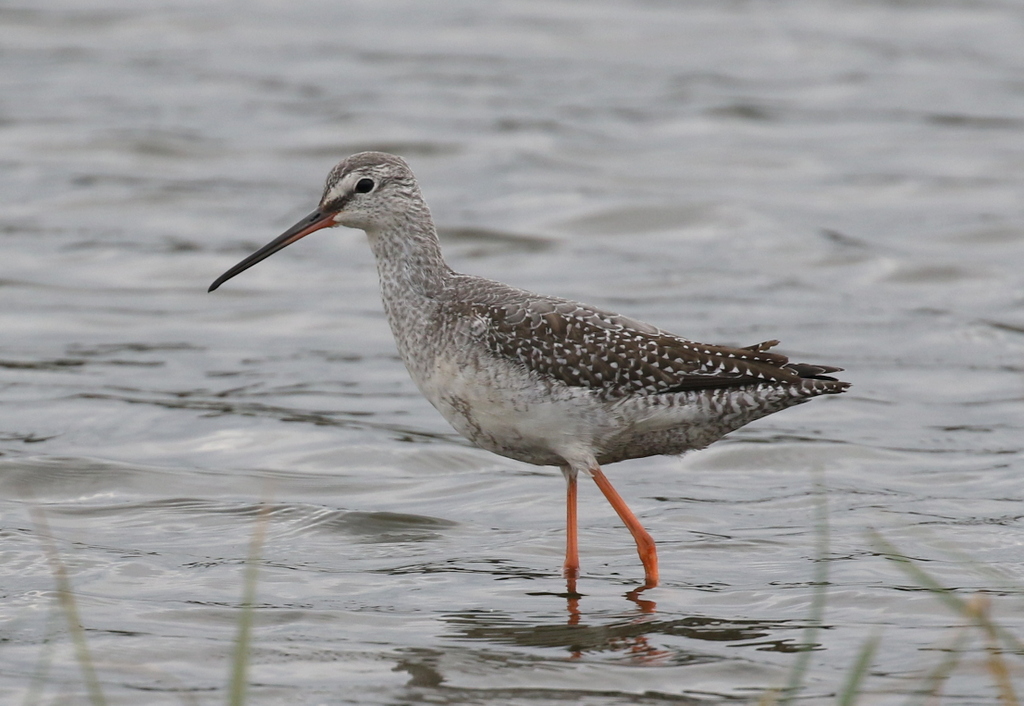 Spotted Redshank – one of the two here, this photo taken a few days ago
Spotted Redshank – one of the two here, this photo taken a few days ago
A couple of Spotted Redshanks were feeding in the deeper water just behind the Curlew Sandpipers. One of the Spotted Redshanks was noticeably darker, a rather dusky bird, still pretty much in full juvenile plumage. The other Spotted Redshank was much paler, white below and paler grey above, but with the same dusky grey wings – another young bird which was already much more advanced on its way in its moult to 1st winter plumage.
At that point, the Red-necked Phalarope flew in to join them. It landed in the water by the Spotted Redshanks and started swimming in circles, stirring up the mud below and picking at the surface at anything which it managed to stir up. We had a great look at it through the scope, and then it started to work its way down to the front and along the edge of the vegetation just in front of us. The Red-necked Phalarope is still pretty much in full juvenile plumage, its dark upperparts with distinctive pale golden lines on the mantle and scapulars.
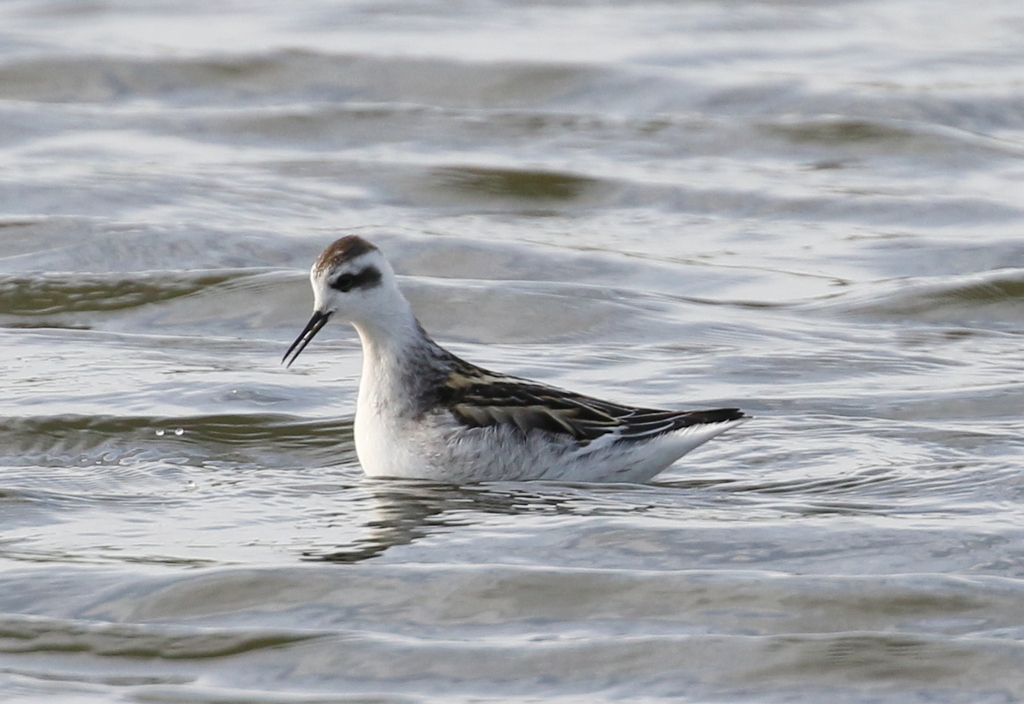 Red-necked Phalarope – showed really well again today
Red-necked Phalarope – showed really well again today
There was a really nice selection of other waders on the Water Meadow today too. A couple of juvenile Ruff came down to join the Dunlin and Curlew Sandpipers at the front. Further back were a single Black-tailed Godwit, one Curlew and a lone Common Redshank. A Common Snipe was feeding unobtrusively on the front edge of the island and we looked across to the wet grass the other side and saw three more Common Snipe there too.
Continuing on round the Quags, a Reed Bunting perched up nicely in the brambles by the path. There was a good sized flock of Linnets feeding on the dried up pool out in the middle of the grass – occasionally they spooked and all flew around in a tight group. As we started to walk up the hillside behind the beach, a couple more small flocks of Linnets came west along the back of the beach, flying purposefully, so presumably migrants on the move. There were a few other birds moving today, most notably a couple of Rock Pipits which flew over us calling.
Looking towards the sea, we noticed a small falcon flying low and fast behind the bushes between us and the beach. A Merlin! It continued out across the Quags, skimming just above the grass, at which point it flushed the big flock of Linnets. They all flew up in alarm and tried to climb up higher into the sky and the Merlin set off after them. We watched for several minutes as the Merlin swooped at them. It managed to separate one Linnet from the flock and the two of them towered higher into the sky, the Linnet trying to stay above the pursuing falcon. Whenever the Merlin dived at it, the Linnet just managed to evade it, but it was touch and go for a while before the Merlin finally gave up and flew on west. Exciting stuff!
At this point we noticed a message saying that four Common Cranes had just been seen flying west over Cley. This meant that they had probably already passed us by – most likely flying west along the ridge inland before dropping down to the coast as they usually do, rather than coming over us. We therefore were not expecting to see them as we raised our binoculars and scanned over the marshes to the east, but there they were. The Cranes were distant, but we could see their distinctive long-necked, long-legged silhouette through the scope as they turned. A real bonus!
A quick look out to sea, and we noticed a single Brent Goose flying past over the water, presumably just arriving back from Russia for the winter. Otherwise, there did not appear to be a lot moving out to sea today and it was quiet too past the gun emplacements, so we set off back down to the Water Meadow. We had heard a Stonechat earlier, and just caught a glimpse of it as it disappeared round behind the reeds, so it was nice to see a pair of them on the fence on the edge of the Quags on our way back past. A single Redpoll flew over calling and disappeared away to the west.
As we walked back past the Quags, we could hear a Bearded Tit calling. When we worked out where the sound was coming from, we could see it perched in the tops of the reeds, swaying in the breeze. From round on the cross track, we had a much better view – it was a female and it appeared to be on its own. It flew a short distance a couple of times and dropped down into the reeds, but each time quickly climbed back up to the tops and started calling.
 Bearded Tit – this lone female was down at the Quags today
Bearded Tit – this lone female was down at the Quags today
The Bearded Tit appeared to be looking for more of its own kind. Some birds disperse away from their breeding reedbeds at this time of year, but they are more often seen in small groups. Eventually, after calling for a while to no avail, it took off, climbed into the sky and set off west.
We set off back up the lane. We heard the Yellowhammer calling again and, as we stopped to try to see it, a couple of Goldcrests came out of the same tree. We followed them up the lane, eventually getting a brief view of one at very close quarters in the hedge right next to us. A tit flock came down the lane the other way and we stopped to admire a couple of Long-tailed Tits. A Chiffchaff was feeding in the garden of the village school.
With the sun out, the raptors started to circle up. Two Common Buzzards appeared over Muckleburgh Hill and a third circled over our heads calling. It was quite warm along the lane now ,out of the wind. There were several butterflies out, Red Admirals, and dragonflies including lots of Common Darters and one or two Migrant Hawkers.
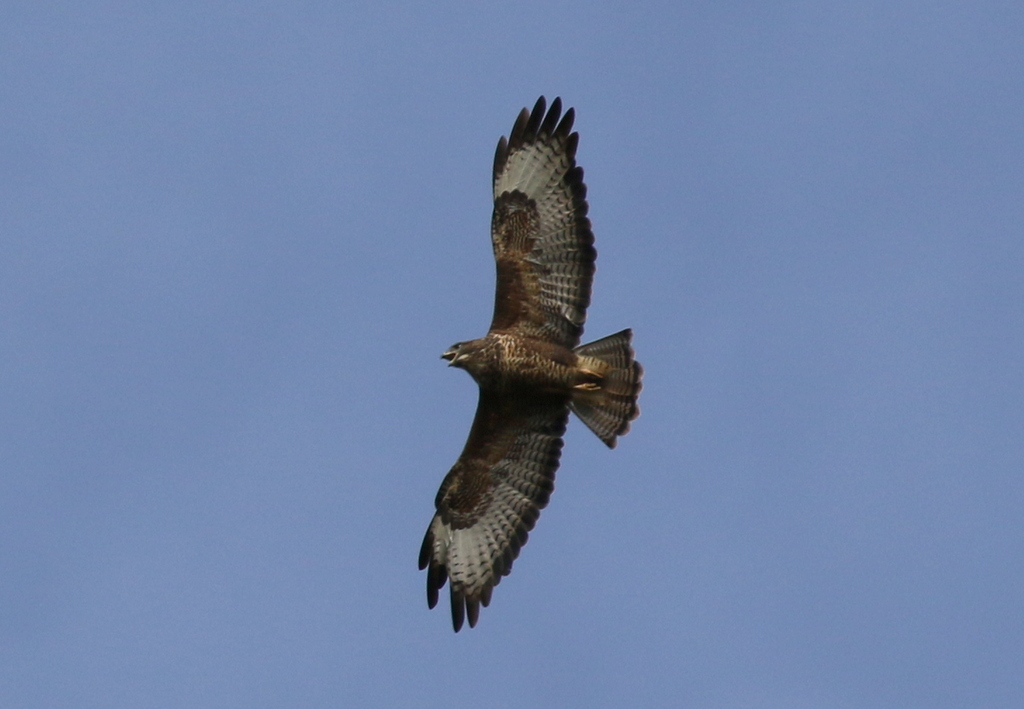 Common Buzzard – circled over the lane, calling
Common Buzzard – circled over the lane, calling
Our next destination was Cley, and before lunch we decided to have a look up along the East Bank. A Mute Swan and Coot on Don’s pool were additions to the day’s list, but the Aylesbury Duck with the Mallards did not count! Out on the grazing marshes the other side, we could see lots of Canada Geese loafing in the grass.
There were a few waders out on the grazing marshes and along the Serpentine too. We stopped for a closer look at a couple of Lapwing – stunning birds, particularly in the sunshine when their glossy green upperparts shone bronze and purple too. There were lots of Ruff – neat brown and buff juveniles, paler white and grey-brown adults, with males and females of very different sizes. A single Common Snipe was hard to see feeding in the wet grass until it ran across out in the open.
At the end of the Serpentine, a small flock of Black-tailed Godwits had gathered to feed, most up to their bellies in the water. The majority were in plain grey non-breeding plumage, but one still had extensive rusty feathering on its breast, the remainder of its summer attire.
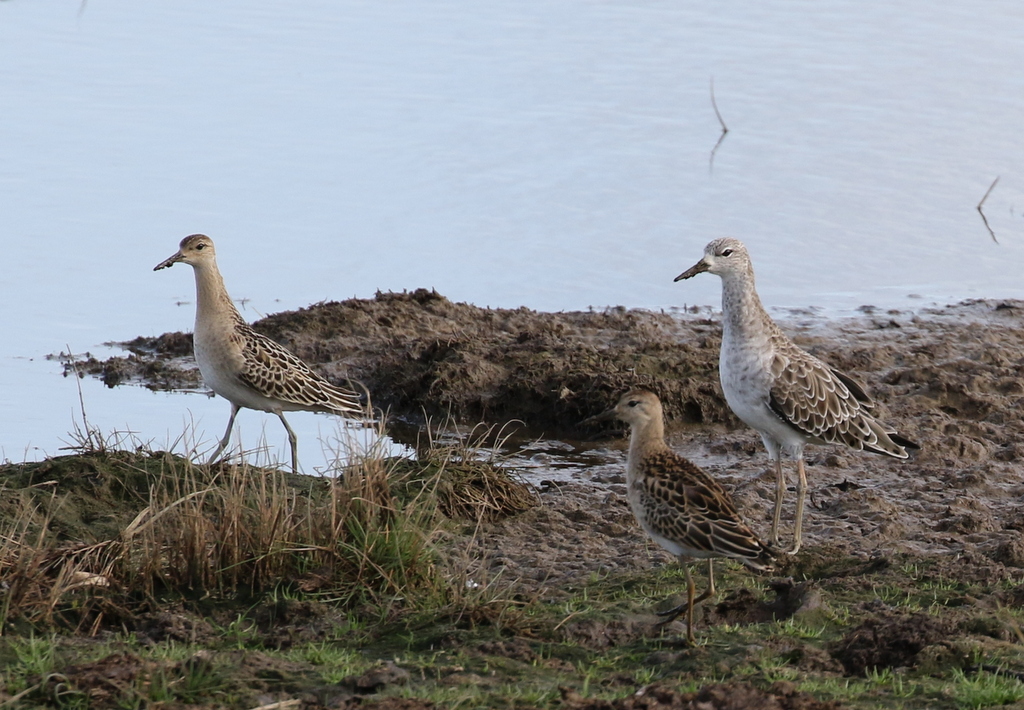 Ruff – an adult and two juveniles
Ruff – an adult and two juveniles
Several small skeins of Pink-footed Geese flew in from the east. We could hear their distinctive high-pitched yelping calls. There were a couple of Greylag Geese too – we could see their paler grey heads and large orange carrot bills.
There were more ducks out on the grazing marshes here. Most of the drakes are still in dull eclipse plumage, but increasingly some are starting to regain their smart breeding dress. The largest number were Wigeon, feeding out on the grass. There were quite a few Teal and Shoveler along the edges of the Serpentine too. Further back, we found first a female Pintail and then a couple of drakes which were starting to look smarter again. There were a few Gadwall sleeping in amongst the Canada Geese as well.
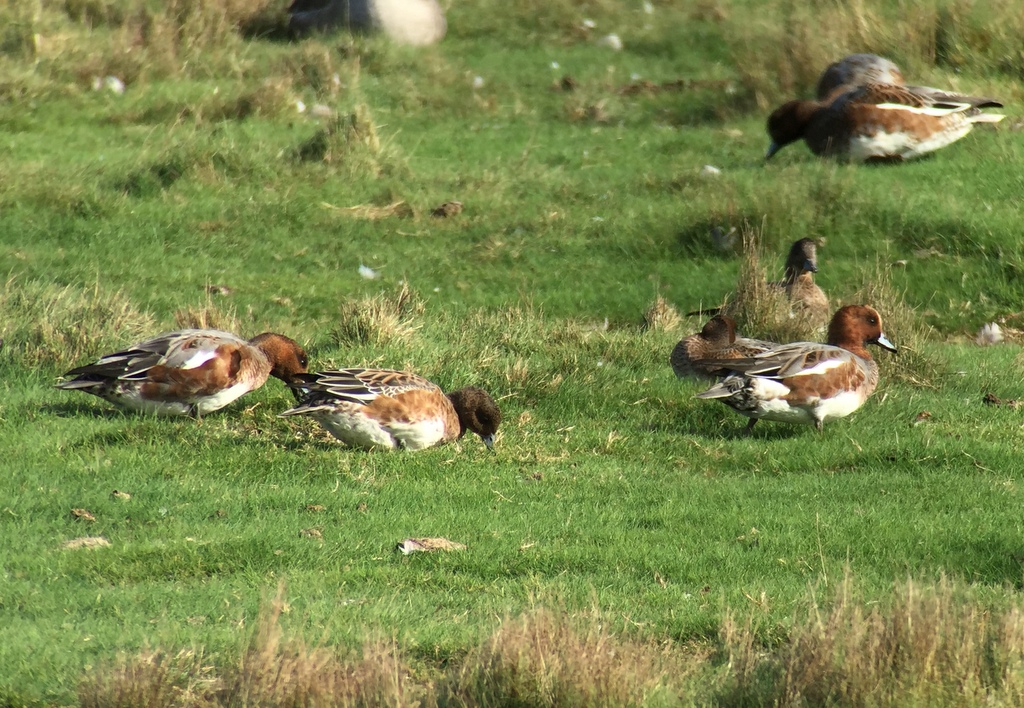 Wigeon – there is a good number now out on the grazing marshes
Wigeon – there is a good number now out on the grazing marshes
A stop at the shelter overlooking Arnold’s Marsh gave us a chance to sit down and get out of the breeze. There were more waders on here – more Curlew, Black-tailed Godwits, Redshanks, Ruff and Dunlin. Scanning through a group of Dunlin, we found a much paler, whiter wader in with them – a lone Sanderling. It had probably just stopped off here briefly on its journey.
A couple of Ringed Plover were hiding in the saltmarsh in the middle – we could just see their black and white heads sticking out. Further over, we found two Grey (aka Black-bellied!) Plover on the islands and, right at the back, a big flock of Golden Plover hunkered down too.
When all the waders flushed, we couldn’t see the cause at first. A few minutes later a Peregrine appeared, just as everything had started to settle down, and spooked them all again. It chased round after a big flock of Black-tailed Godwits first, then seemed to head back towards Salthouse, before we picked it up again over the beach, chasing a Redshank. Like the Merlin we had seen earlier, the Peregrine chased after the Redshank relentlessly for several minutes, swerving, climbing, stooping at it repeatedly and passing within what looked like millimetres of it, before we eventually lost sight of them.
Out at the beach, the sea looked fairly quiet still. We picked up a single Great Crested Grebe out on the water and a Razorbill or two as well. Two or three Gannets were circling out in the distance and periodically plunging into the sea. There did not appear to be much moving offshore, with a couple of Ringed Plover flying in off the sea being the highlight.
Time was getting on now, so we set off back to the car. There were several Little Egrets on the brackish lagoons and one fishing right down the front of Arnold’s Marsh. We could hear more Bearded Tits calling out in the reedbed, but they were keeping well tucked down today out the wind. Then it was back to the Visitor Centre for a late lunch.
 Little Egret – feeding on the front of Arnold’s Marsh
Little Egret – feeding on the front of Arnold’s Marsh
After lunch, we headed out to the hides in the middle of the reserve. As we walked out along the boardwalk, a pair of Stonechats were perched on the fence posts on the edge of the reedbed. They would periodically flycatch out over the reeds, hovering before flicking back to one of the posts.
From Dauke’s Hide, we could see there were lots of birds on Simmond’s Scrape today. It didn’t take long to find our first target. Scanning carefully around the islands, we found several Little Stints. On our first count we got to nine, then shortly afterwards we got up to thirteen. They were mostly quite widely scattered, but when all the small waders flushed from time to time, they would bunch up together for a while after they landed. By the end, we had managed to count at least 18 Little Stints on here today, an impressive number.
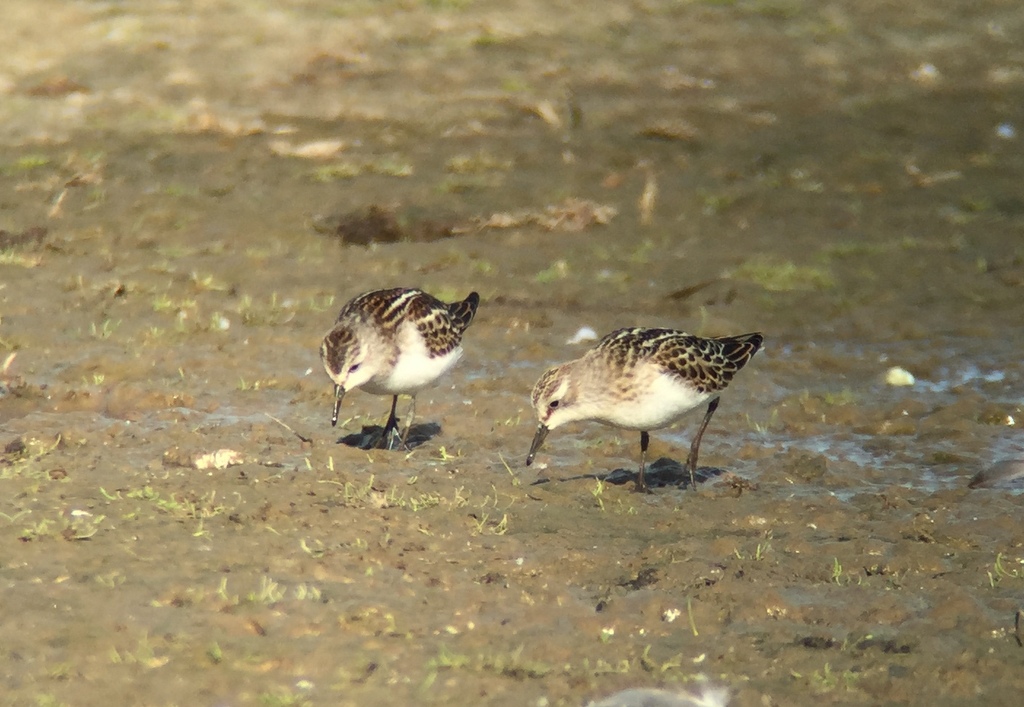 Little Stints – two of at least 18 on here today, all juveniles
Little Stints – two of at least 18 on here today, all juveniles
We got some of the Little Stints in the scope and had a closer look at them. We could see they were small, particularly when one walked past a Dunlin, which in itself is not a big wader, at which point they looked tiny! They were all juveniles – we could see their pale mantle braces and split supercilium.
There were three Curlew Sandpipers on here too, again all juveniles. They were feeding separately, but occasionally one or other of them would fly in with one of the little groups of Dunlin and land on the front edge of the nearest island, where we could get a really good look at it.
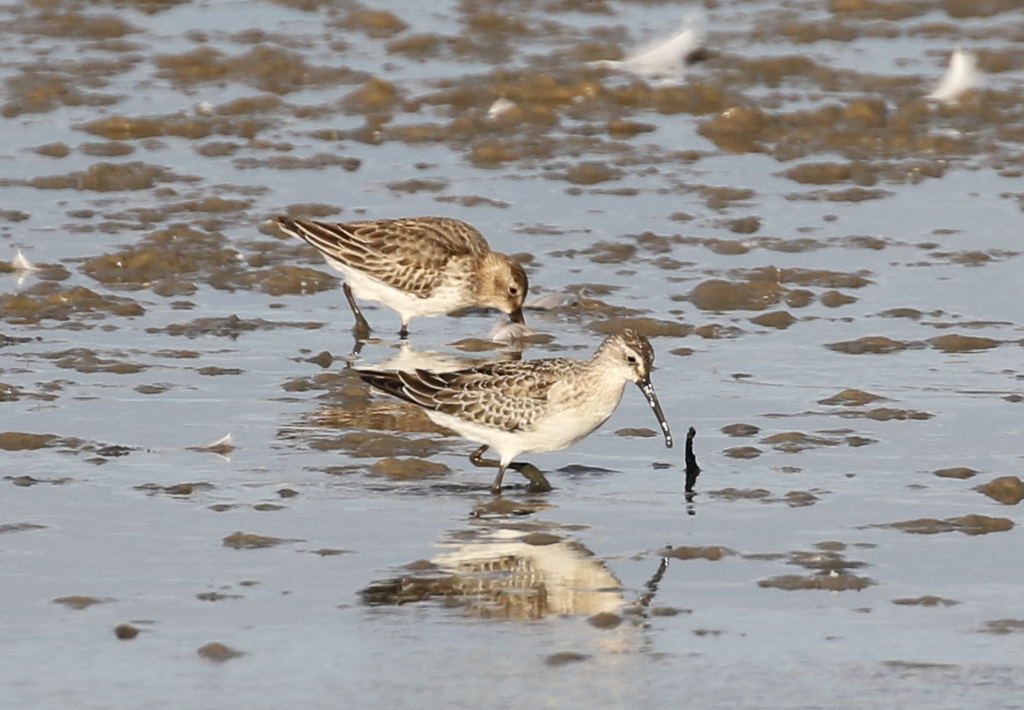 Curlew Sandpiper – a juvenile, in front of a juvenile Dunlin
Curlew Sandpiper – a juvenile, in front of a juvenile Dunlin
In with the Little Stints on the drier mud in the middle of the islands, there were a few Ringed Plovers too. At one point, a lone Knot appeared at the back briefly, with a single Dunlin and one of the Curlew Sandpipers. Otherwise, the waders on here were mostly more Ruff, along with a few Lapwing and one or two Redshank. We could hear Greenshank calling from time to time, but did not manage to see one on either of the scrapes. A Common Snipe was more obliging, feeding for a while in the grass on the far side of the channel in front of the hide.
We had heard a couple of Cetti’s Warblers singing earlier today, but as is typical they were keeping well hidden. So when one started calling just outside the windows of the hide, we didn’t really expect to see it, but there it was on the edge of the reeds. Unfortunately, it did not stay very long and quickly darted back into the reeds before everyone could get a good look at it, before flying across the channel and disappearing into the vegetation the other side.
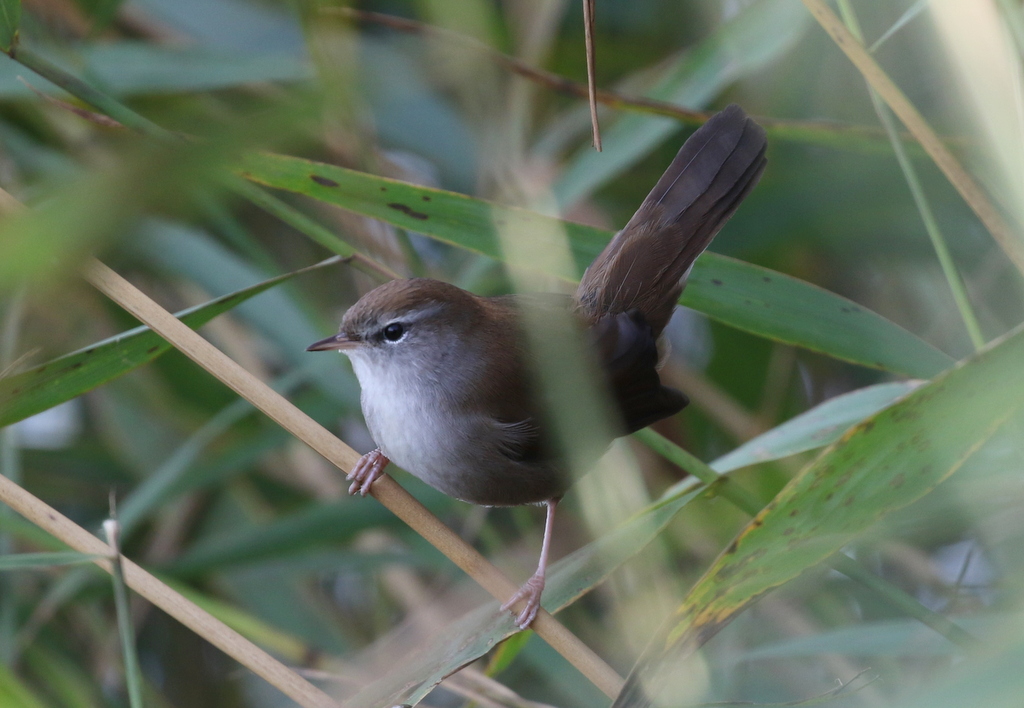 Cetti’s Warbler – perched just briefly in the reeds right outside the hide
Cetti’s Warbler – perched just briefly in the reeds right outside the hide
The Water Rail put on a better performance. The next time we glanced over towards the reeds just outside the hide, we noticed something moving at the base out of the corner of our eye. A quick look confirmed it was a Water Rail. It was well hidden in the reeds at first, but gradually came out into the open, picking its way furtively in and out of the vegetation.
It worked its way towards us and soon the Water Rail was right out in the open just outside the hide window. Stunning views and so close we almost had to zoom out to take a photo! It was nervous, but stayed out in view for several minutes before finally deciding it preferred the shelter of the reeds.
 Water Rail – stunning views right outside the window of the hide
Water Rail – stunning views right outside the window of the hide
A while later, the Water Rail crept out of the reeds again. This time it picked around for a few minutes, gradually working its way out into the open, before starting to swim out through the open, cut vegetation towards the channel. It obviously didn’t fancy swimming right across the open water, because it suddenly took off and flew over to the other side, dropping into the reeds and squealing as it did so.
There are lots of Pink-footed Geese at Cley at the moment, unusually so for this time of the year. There were several thousand loafing around on the islands at the back of Simmond’s Scrape, and on the grazing marshes beyond. Periodically groups would fly in and out – it is amazing to watch and listen to the skeins of Pinkfeet as they fly in to join the throng.
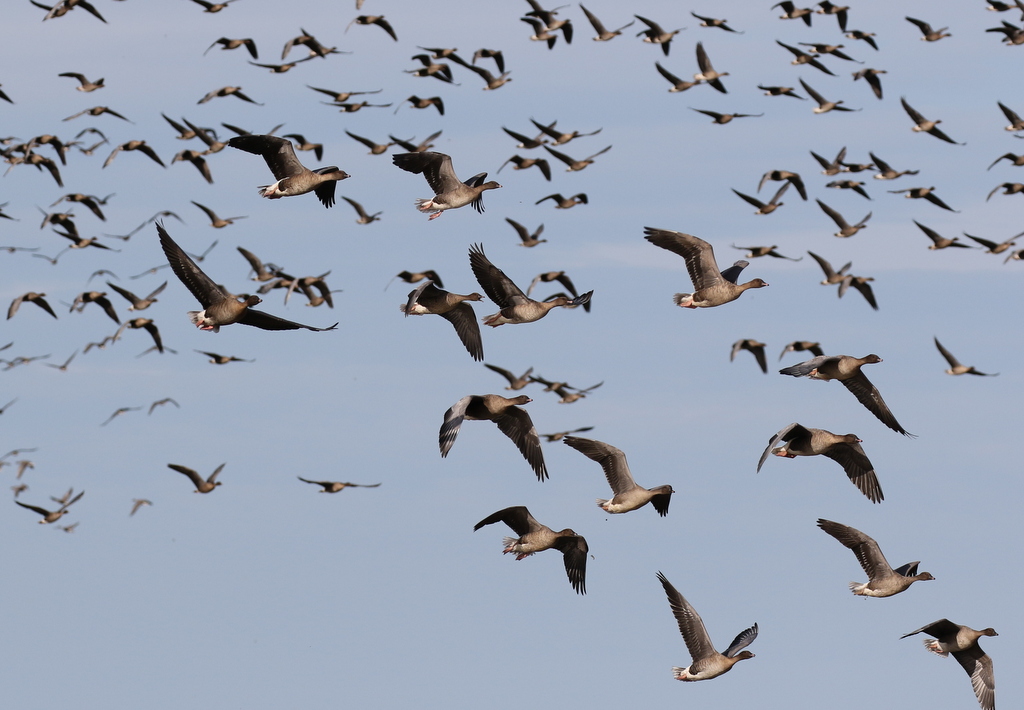 Pink-footed Geese – there were several thousand at Cley today
Pink-footed Geese – there were several thousand at Cley today
There had been no sign of any Marsh Harriers earlier today, but finally when the waders all scattered, we looked up to see a female flying past, over the scrape. We made our way to Avocet Hide next, and when just the small waders all took off again, we looked across to see a Sparrowhawk flying low over the grass at the back of the scrape, rounding off a very nice selection of raptors today.
We had hoped we might catch a few early gulls coming in to bathe on Whitwell Scrape before going to roost, although possibly given the sunny weather, birds would be slower to come in today. There were a few Lesser Black-backed Gulls dropping in and we could see a single young (1st calendar year) Common Gull and a Herring Gull in with the Black-headed Gulls.
Then it was time to make our way back. A few Collared Doves on the wires and a Stock Dove which flew off from the grazing marsh were the final additions to today’s list. We will see what tomorrow will bring!
















